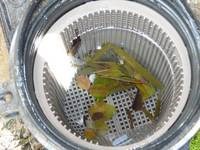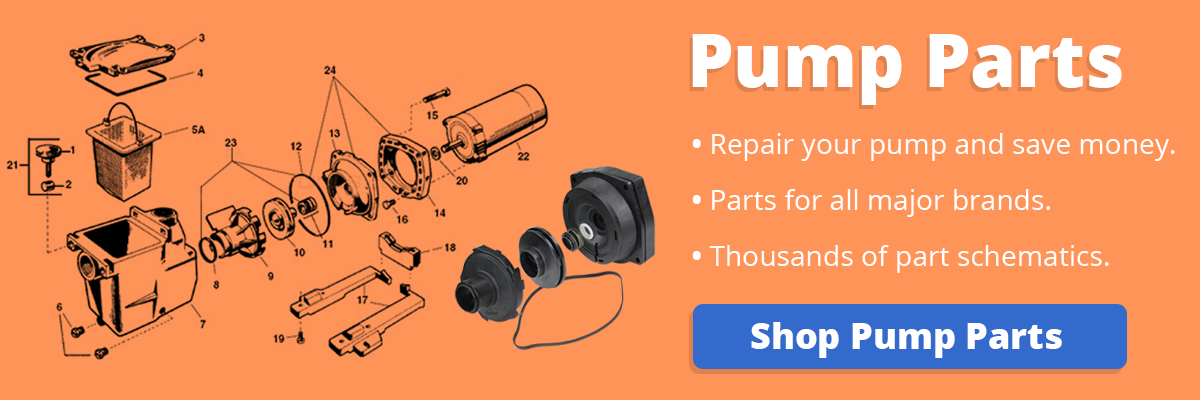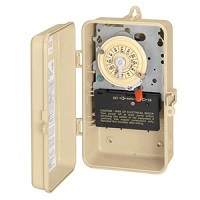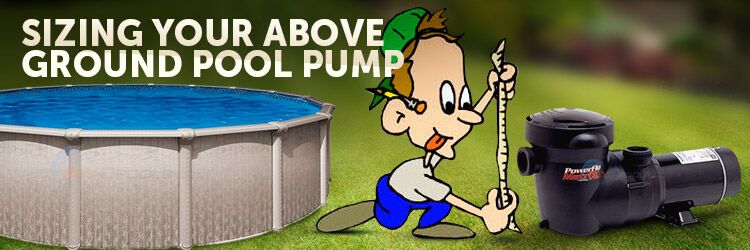The pool pump is literally the heart of your pool’s circulation system. But just like our own hearts, we have a tendency to neglect the health and well-being of the pool pump and then freak out when it’s not working properly. There are probably dozens of pool pump mistakes out there. . . here are our top 5.
Not Cleaning Pump Basket
 Let’s start with the very basics. The pump strainer basket exists to catch debris but it can’t clean itself. You need to reach in there and get the gunk out. If you don’t, the pool will have decreased water flow which means reduced filtration and ultimately, the dreaded algae bloom. The pump basket should be cleared out weekly and even more frequently during the fall and spring when there is more debris in the pool. Learn more here about how to clean your pump strainer basket.
Let’s start with the very basics. The pump strainer basket exists to catch debris but it can’t clean itself. You need to reach in there and get the gunk out. If you don’t, the pool will have decreased water flow which means reduced filtration and ultimately, the dreaded algae bloom. The pump basket should be cleared out weekly and even more frequently during the fall and spring when there is more debris in the pool. Learn more here about how to clean your pump strainer basket.

Running Pump Too Little or Too Much
Some pool owners, desperate to save money on their electric bills, actually cost themselves more in the long run by not running the pump long enough. To maintain water quality and safety, all of the water in your pool should be turned over (meaning filtered) once a day. Depending on the gallons per minute your pump is moving, this usually takes 8 – 12 hours. If you don’t give all the water a chance to pass through the filter, you can end up with dirty, cloudy water, algae and the need to spend more on chemicals and maintenance than you would’ve given to your utility company to run the pump a little longer.
the pump long enough. To maintain water quality and safety, all of the water in your pool should be turned over (meaning filtered) once a day. Depending on the gallons per minute your pump is moving, this usually takes 8 – 12 hours. If you don’t give all the water a chance to pass through the filter, you can end up with dirty, cloudy water, algae and the need to spend more on chemicals and maintenance than you would’ve given to your utility company to run the pump a little longer.
On the flip side, there is running the pump too long. Some believe in keeping it going 24/7 which might be necessary under certain conditions but for most pools is just wasteful overkill. It drains both energy and money while causing unnecessary strain on the pool pump motor. Your pump will burn out more quickly and require replacement of parts or the entire unit. Plus, you are driving your neighbors crazy! Give them a break from that humming motor and save some money in the process. For standard residential pools with moderate use, you only need to turn over all the water once in a 24 hour time period. If you are into the math behind pump run times and savings, read our How to Reduce Your Pool Pump Energy Bill guide.
Sizing Pump Incorrectly
There is a very persistent myth in the pool world that the higher the horsepower, the better. As a result, it is probably safe to say that the majority of pools have oversized pumps. We regularly hear from customers with a relatively small pool (~ 10,000 gallons) and a pump that is moving 2 – 3 times the gallons per minute required. This means unnecessarily high electric bills and a lot of wasted energy. Too large of a pump can cause poor filter performance and even damage it, if the filter is not also oversized accordingly. Another possible consequence is pump cavitation in which bubbles form in the water inside the pump and then burst with great force, resulting in damage to the impeller and other internal parts.
Conversely, some pool owners try to save a few bucks by buying a lower horsepower pump that is too small for their pool’s demands. This is especially true when a spa and other water features, such as deck jets or waterfalls, are tied into the pool pump. Throw an automatic suction cleaner into the mix and that undersized pump is overloaded.
The bottom line? Do the math to calculate how many gallons are in your pool (and spa if applicable) and how many gallons per minute are required to filter all of that water in 8 – 12 hours. Then consult the manufacturer’s pump performance charts to determine what pump actually meets your needs. Or skip all that, contact us and we’ll do the legwork for you!
Not Priming Pump / Running Dry
Most in-ground pool pumps are self-priming but do not mistakenly think this means your pump can initially prime itself. “Self-priming” refers to the pump being able to reprime, and this depends upon a proper initial prime and maintenance. Priming a pump means filling the intake with water. Then upon start, the pump will push any air out through the discharge. Read our step-by-step priming guide for all the details.
A loss of prime will cause the pump to run dry which you never want to do. Keeping an eye on the pool water level is a must – don’t let it drop below the skimmer opening. If the pump has no water to pull from the skimmer, it will draw air instead and lose prime which leads to running dry. At the least, this will ruin the motor shaft seal which is what prevents water from getting inside the motor. If it keeps running dry, the pump heats up and so does the water inside. Commence melting plastic. The motor might survive due to the high temp sensor kicking in but the wet end of the pump will be a casualty. If your pump has run dry and appears to have survived, replace the shaft seal!
Not Changing the Shaft Seal During Motor Replacement
 I literally grind my teeth over this one. Replacement pool pump motors are an extremely popular product for us – and with good reason. In the majority of cases, when a pump fails, the wet end is fine and only the motor needs to be replaced. Since a pump motor is roughly half the price of a new pump, it makes often sense to keep the existing wet end and just buy a new motor. Especially true for DIYers who don’t have to pay an installer.
I literally grind my teeth over this one. Replacement pool pump motors are an extremely popular product for us – and with good reason. In the majority of cases, when a pump fails, the wet end is fine and only the motor needs to be replaced. Since a pump motor is roughly half the price of a new pump, it makes often sense to keep the existing wet end and just buy a new motor. Especially true for DIYers who don’t have to pay an installer.
But so many people buy just the motor and neglect the small yet extremely important shaft seal. This seal keeps water out of the motor (water inside motor + time = failed motor). Yes, your existing motor will already have a seal on the shaft and it might appear to be in good shape and ok to reuse. However, shaft seals warp over time. If you install the old seal on a new motor, there is a good chance it will not mate properly, leading to leakage which voids the warranty on the new motor.
So don’t skip the new shaft seal! Depending on the pump model, you’re looking at about $15 – $30 to protect a new motor that is worth much more than that. Invest those few extra bucks – you will not regret it. While you’re at it, motor replacement is a great opportunity to upgrade other internal parts most likely to fail. Check for our complete tune up kits, available for many of the most common pool pumps. These include the shaft seal, along with o-rings, gaskets and lubricant. For help with replacing the seal, check out our how to guide and video.












Hi, how can I tell if my pump is bad? I’m having a terrible time with algae and not being able to clear it up. The return is pumping water to the pool like always. Very strong. All baskets are cleaned out. The gage is reading 15…
I did notice it spit algae out as soon as I turned it on today? That’s something I haven’t noticed before.
Please help. :/ Thank you.
That doesn’t sound like a pump problem, it sounds like a chemical problem. Read this guide, and watch the video for help: How to Clean a Green Pool?
We just put up a pool we just bought off someone and I need sand for the sand filter and got to get a few new pieces for the sand filter can I still hook up the pump and not the sand filter to run it for a day to just circulate the water and shock it.
Hello there. I’m getting a higher than normal pressure reading (25 psi) with a motor that’s in need of a new shaft seal. It’s leaking a lot. Would the shaft seal problem be the cause of the high pressure? Or is it something else? Thanks.
A leaky shaft seal is not going to cause a build of pressure. It is more likely that your filter needs a cleaning.
But that shaft seal needs replacing as quick as possible to prevent further damage to your motor.
I have a new multi port valve on a filter that we purchased less than two years ago. Water is leaking out the backwash hose while in filter mode. I have checked the spider gasket and it looks perfectly fine. I even switched the top of the multi port valve with the new system to try to help with the water flowing. It helped for a short while, but then started to leak out again. The strange part is that it starts off dry, starts to leak out slowly, and then is about halfway out the hose. It is draining my pool repeatedly and is very frustrating! Any feedback would be greatly appreciated.
I have an inground pool using a Hayward DE 4820 Pro Grid filter and a Polaris Caretaker 99 infloor cleaner. In-between backwashes, as the filter pressure increases near to when a backwash would occur, I am getting a considerable amount of larger debris passing through the filter and completely clogging up the intake screen of the 5 port valve. This stops the cleaning process and I have to clean the screen frequently until I backwash. This only seems to happen when the filter pressure approaches 30psi, which is the point where I would normally backwash the system. I do not have any noticeable DE in the pool and the water is normally beautifully clear.
I have sand in my above ground pool can I vacuum it out through my pool filter or will it tear up the pump if I can should I use wast out or filter
Yes, you can vacuum the sand without it hurting your pump’s guts.
I have obvious DE in my pool. Should I turn off the pool pump until my pool service can fix the source of the problem? I’m worried that the DE is abrasive on the pump and other components of the system.
DE powder is not abrasive, and should not affect your pool surface. Outside of giving your pool a murky look and being a sign of damaged filter equipment, it should not pose much harm suspended in your pool water.
We just dug our pump system down a bit to help it run better according to our local pool lady. We had a torrential rain tonight, and the dug down area held water. When I went out to check the pump was not running but still plugged in. Do we stand a chance of getting this pump to run again once it dries out? Do you have any advice on what we can do to help it? Thanks!
It may run again, only time will tell. Let the motor dry out and make sure you have it on a GFCI.
Hi. We just had the pool opened and the pump turns on fine but it only runs the skimmers for about an hour and then they stop. But the pump is still on.
Well first, is there enough water in the pool to properly cover the skimmers. Also when the skimmers stop, is there water in the pump or is there a large air bubble?
And lastly, what is the filter’s pressure gauge doing? Does it spike, take a dive or stay constant?
I have a Hayward EC-45 earth filter. Since opening the pool several days ago we have been having issues losing water flow back to the pool as it’s very low after running the filter for about an hour and a half. At first we just figured it was because the water was green and we had to just get the water cleared up and take care of the filter along the way. We were basically bumping and back washing the filter in order to keep it running so we could add our chemicals. But again we only had good flow for about an hour and a half before having to bump or back wash. We now have the water pretty well cleared up but our filter is still acting the same even after a thorough cleaning of the fingers as well as soaking them in muratic acid for 6 hours. After put back together and earth added the pressure was like a raging rapid when you start the filter up and after 90 minutes, time to bump the filter. When I went to do it today there was very little resistance when I pulled down to bump it. This seemed strange to me so when I went back to do it the next time, I just shut the filter off for 30 seconds and restarted it without bumping it and it roars like a raging rapid. I’m totally stumped here, please help. Seems to be a lot of air bubbles on top of the water when I re-start the filter. Any help is appreciated.
Let’s start with the pump first. When you see feel the pressure take a dive, does the pump’s lid have large air bubbles, or a complete pocket of air? Also, does it build as time goes by?
Besides backwashing, have you hosed off the fingers or gave them a chemical soak? We suggest giving DE grids and cartridges a deep cleaning once a year to clear out any gunk clogging the pores. If you have not done this in awhile, your DE fingers may be so gunked up that they can only handle about an hour and a half of work before they need to be bumped.
I looked at my filter basket the other day and it looked like it was bone dry and there was lots of debris swirling around. I sent a text to my pool guy and he said that if there was debris swirling, there was water in it but I just couldn’t see the water. He says he’s asked this all the time. He said debris can’t swirl without water. Doesn’t sound right to me.
Is there steady water pressure coming out of your returns? If the answer is yes, then there is water in your pump.
Hi, I have a Hayward 1hp pump and sand filter on my 24′ above ground pool. I have adjusted all levels to be within spec (chlorine, ph etc.) Still have a blue cloudy pool after running filter for 48 hours straight. After backwashing my psi reads 10, and water flows nice and strong out of the return jet. After some hours, I notice the water barely flowing out of the return jet and barely sucking through the skimmer. Psi still 10. I turn it off, backwash for a minute, turn it to normal filter setting and once again water flows strong out of the return jet. Some hours later, same thing. Any help is appreciated, I’m losing my mind here!
Also, I have had the water tested by the local pool store. It seems my water is cloudy because the lack of continuous proper filtration due to my loss of flow through my filter. Sand is only one season old. I don’t see air bubbles in my suction side skimmer, it is full and not leaking.
Also, I have had the water tested by the local pool store. It seems my water is cloudy because the lack of continuous proper filtration due to my loss of flow through my filter. Sand is only one season old. I don’t see air bubbles in my suction side skimmer, it is full and not leaking.
I could write a bunch a possible solution to your problem but that would waste both of our times so I’ll cut to the chase. Here it goes. “Get rid of that sand filter and replace it with a good quality cartridge type filter”.
Jason did you find out the cause of your issue we are having the exact same problem.
Hi, Mathew. We left the water shut off valve on top of the filter cartridge open, the pump had been on for about an hour, we heard it as soon as it started to make a noise because of the drop in pool level and not enough water going through the skimmer, there was still water coming out. We closed the screw and turned the handle to bottom. After we’d filled the pool and put it back on skimmer, we noticed that the pump was noisier than before. Could you possibly help please.
Was the motor being splashed or getting flooded? Also, was the pump running dry at any time?
The result of this mistake could be bad bearings or a motor that was overheating and caused internal damage and possibly melted pump parts. You might want to open the pump to check if any of the pump parts like the impeller, seal plate or shaft seal have been damaged.
Everything works great on m pool except bugs and debris do not go into skimmer. They just float around on top of water.
Have you tried adjusting your return jets to create more so floating debris gets caught in a circular current? This should work all the debris towards your skimmer for easy capture.
Matthew,
I installed a new Polaris PB4-60 Pressure Cleaner Booster Pump today because the old one was leaking badly and finally started making a loud screeching noise while running. After letting it run for about 30 minutes I noticed it seemed to be a bit noisy and the new inlet hose was shaking quite a bit. When I took hold of the inlet hose it was so hot I could not hold it for more than a few seconds. I immediately turned off the pump.
Could this be happening because the old wiring is 120V instead of 220V? The new pump uses 220V and the old pump says it is 220V on the label but maybe it was rewired for 120V??
If this could be the problem how do I figure out the wiring voltage? I was trying to save some money but at this point I’m thinking it may be time to call an expert. I’m new to pool ownership and figuring out this stuff as I go.
PB-460s use dual voltage motors that can be set to operate on 115 or 230 volts. The terminal board has a jumper or a knob that allows you to set the motor to the appropriate voltage.
The first thing you need to do, figure out if you are feeding it 230 or 115. Secondly, set the motor to the correct voltage. 230-volt wires are usually coded red and black; or black and black with a ground wire. 115 volts should be color coded white and black, with a ground wire.
So I have a indoor in ground pool. So it doesn’t have any debris. Do I need to keep my pump running for the normal 8 hours. Or can I cut it off for awhile and give it a break
Because your pool is indoors, your chlorine needs are likely significantly less then a pool exposed to direct sunlight, pollen, and other chlorine hogs.
Your situation is unique so I would play-it-by-ear. Lessen your time by an hour each week, then at the end of each week check water for clarity. Test chemical levels to determine if your pool is stable, or if you need to up the run time by an hour. Continue this until you find your pool water’s happy point.
I’m not sure if this is the correct place for this question but I have an in ground pool and I was starting up the pump today. I wanted to drain some of the water out and accidentally turned to control to the “closed” setting while it was running. Did I do something terrible? The tabs on he filter lid (a couple of them) broke and now it won’t circulate water at all. It was only on there maybe 20 seconds before I got it turned off. When I try to change the settings nothing happens. What did I do? Is this going to be expensive to fix?
First things first, never turn the multiport valve while the pump is running. No matter the setting, operating a multiport valve while the pump is on is a recipe for a mangled valve.
As for your particular case, your next step is to open up the valve. Remove the six to eights that secure the lid/handle assembly. Once inside you can check to see what is broken, loose or gone. Without knowing which filter you have, I am not sure about the tabs you are referring to.
Opened our above ground pool yesterday and everything was running well. This morning , got up and the water was below the skimmer. Should the valve on the pump be on or off when running? The water is coming out of the backwash. All the rest of the valves are in the right position, just not sure of the one on the pump.n
Water escaping from the backwash is the sign of a bad diverter gasket in the filter valve.
I’m not sure about the pump valve you’re referring too, but you may be using that term instead of multuport/backwash valve.
I have an above ground pool that we recently started working with opening it up for the summer. I shocked it last night and left the pump on to filter throughout the night. I went to bed at 11 p.m. and the pool was doing good. I woke up at 5:30 a.m. and noticed water level dropped down below skimmer, the pump was not running, and the plug in from pump to extension cord was burnt. It was plugged into a GFI. Not sure if motor burnt out or I need to just replace the cord.
I would start with the cord, because it is a lot cheaper than a motor. If that does not fix the problem then you can start troubleshooting the pool pump motor
my alkaline is 120 my ph is good my pool is a 25 foot above ground pool what is the best stuff to use and how much also I had to shock it and my water is cloudy
If you are the same Carla from all the previous posts, read the following links: How To Go From Cloudy To A Crystal Clear Pool, Marlig Fix-a-Leak, How to Balance Your Pool Water
Hi there, I’ve had a 15,000gallon pool for 8 months now and there’s a small leak in the plumbing outside, have to fill with water once a week, goes down about 2 inches a week, then the kids came over and played in the pool, the very next day it went down 6 inches! Tried some the and couldn’t find anything in the pool as far as leaks, so why it went down so far in 1 day?? Dont ha e the money to fix at the moment, should I just let it go? Until I do? And if it falls below the skimmer I know that’s a problem! Just turn the pump off permantley? Till I have the money? Thank you
If you turn off the pump for a few days (or longer,) your pool is going to become a swamp. Have you tried Marlig Fix-a-Leak? This is a good stopgap until you can afford a more costly repair.
I,ve never heard about that. Ill try it and let you know the results.
Every time I use granular shock it ends up on pool floor. I sweep it out, cloud up the pool, and have the granulars back on the floor the next day. Do I have a possible bad lateral? I don’t want to vac to waste and loose the chlorine I just put in do I?
Charlie,
How are you adding the granules to the pool? Are you dissolving the granular shock in a bucket of warm water before adding it to the pool? The dissolve-bucket method is the correct way to add shock to prevent the granules from settling on the pool floor, which can cause staining.
it only leaks when I turn the pump on
Well then, don’t turn on the pump. jk
Where is the leak coming from?
underneath the filter cant
see it it it comes out from under the base that it sits on
The leak may be coming from the filter tank itself, which usually leads replacing the whole filter. Some try to epoxy the crack but the placement of your leak makes it extremely tough.
just got my above ground pool last year I open my pool the other day turned on the pump came back later an found water its coming from underneath the sand filter can I still run my pump until I get it fix
You can run the pool, but you are just going to lose more water, if not make the problem worse. Do you know if there is a crack in the filter’s shell?